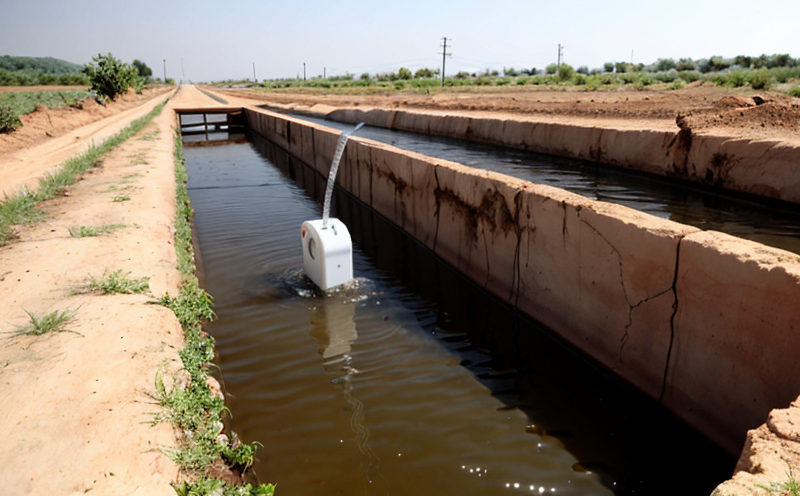ASTM D3559 Lead in Water by AAS Testing
The ASTM D3559 method is a widely recognized standard that allows laboratories to determine trace amounts of lead in water using atomic absorption spectrophotometry (AAS). This test is crucial for mining operations where the quality of mine water and groundwater can significantly impact both internal processes and external compliance. The presence of lead, even in minute quantities, poses health risks to personnel and the environment alike.
In the context of mining, lead contamination often arises from various sources such as tailings ponds, waste rock piles, and runoff from processing plants. Ensuring that mine water meets regulatory standards not only protects workers but also helps maintain a positive public image. This is particularly important given increasing scrutiny on environmental practices by regulators and stakeholders.
The ASTM D3559 method is designed to provide accurate results for lead concentrations down to 0.2 μg/L, which aligns with the strictest regulatory requirements globally. The process involves several critical steps: sampling, digestion of water samples, and subsequent analysis using an atomic absorption spectrophotometer (AAS). Proper sample preparation is paramount; this includes ensuring that all samples are free from interfering elements before being introduced to the AAS instrument.
The accuracy and precision of results obtained through ASTM D3559 depend heavily on standardized procedures. These include the use of certified reference materials, calibration standards, and quality control measures throughout each analytical step. Regular method validation ensures that every measurement adheres strictly to the outlined procedure as per ISO 17025 accreditation requirements.
For mining companies operating in regions with stringent water quality regulations like those set forth by OSHA or EPA guidelines for lead exposure limits, compliance is non-negotiable. By employing ASTM D3559 testing services, enterprises can ensure they remain compliant while also safeguarding their reputation and workforce safety.
In summary, the ASTM D3559 Lead in Water by AAS Testing provides a reliable means of detecting trace levels of lead within mine waters and groundwaters. Its importance cannot be overstated given its role in maintaining compliance with health and environmental standards.
Scope and Methodology
The scope of ASTM D3559 encompasses the determination of lead in water samples collected from mining operations, including surface waters like tailing pond effluents and groundwater sources. The method specifically targets lead concentrations ranging between 0.2 μg/L up to several milligrams per liter depending on the sample matrix.
- Sample Collection: Samples should be collected following best practices outlined in ASTM D1129, ensuring that they represent typical conditions found within mining facilities.
- Digestion of Samples: Digestion is carried out using nitric acid and perchloric acid to transform complex compounds into simpler forms suitable for analysis by AAS.
- Spectrophotometric Measurement: Following digestion, the sample is measured against calibration standards using an atomic absorption spectrometer. This step involves careful selection of wavelengths specific to lead ions.
The methodology ensures that results are accurate and reproducible across different laboratories adhering to ASTM D3559 protocols.
Why Choose This Test
- Regulatory Compliance: Ensures strict adherence to international standards for lead content in water, supporting compliance with OSHA and EPA regulations.
- Absence of Interference: Advanced AAS technology minimizes interferences from other elements present in mine waters, providing precise measurements.
- Quality Assurance: Continuous monitoring through rigorous QC protocols ensures consistent results over time.
- Rapid Turnaround: Our efficient processing times allow for timely reporting which is essential during emergency situations or routine audits.
Mining companies benefit from choosing ASTM D3559 Lead in Water by AAS Testing not only because it meets stringent regulatory requirements but also because it provides reliable data that can inform critical decisions about process adjustments and remediation efforts. The test’s ability to detect even the smallest traces of lead makes it indispensable for maintaining high standards of environmental stewardship.
International Acceptance and Recognition
- Global Standard: ASTM D3559 is an internationally recognized standard that sets a benchmark for lead detection in water samples. Its adoption by numerous countries ensures uniformity in testing protocols worldwide.
- Compliance with ISO Standards: The method aligns closely with ISO 17025 requirements, certifying the laboratory’s proficiency in conducting accurate and reliable analyses.
The widespread acceptance of ASTM D3559 enhances its credibility among regulatory bodies and industry stakeholders. By leveraging this globally recognized standard, mining companies can ensure their operations meet the highest international standards without compromising on quality or accuracy.





